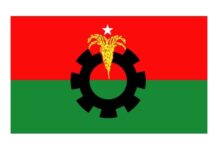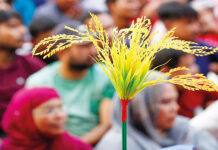23 June is a significant date for Awami League. This is the day it was founded 68 long years ago in 1949. Political parties crop up like mushrooms in this country and then suddenly burst like bubbles into nothingness. And parties have been split into factions time and again. Even Awami League has had its share of splits. But the mainstream Awami League remains alive and active. Birthday greetings to the innumerable leaders and workers of Awami League.
A party’s well-being doesn’t depend on whether it is old or new. Actually, as the great writer Saratchandra observed in this novel Srikanta, ‘mere survival is not the measure of success. After all, enormous elephants die off, but cockroaches survive.’ Muslim League was established in December 1906 in Dhaka, but fell into rot in 1948. Yet within five years of its birth, Awami League managed to win the majority votes of the people in 1954.
Seven decades have passed since then. The question naturally arises, how far has Awami League come? Awami League can no longer be categorized as a mere political party like any of the numerous parties that have randomly sprung up. Over the decades, Awami League has formed the government several times. Is ideological politics have transformed into power politics. Power politics have two aspects. A party has to go to government to implement its policies and programmes.
That is why it is so important to ascend to the helm of state power. Power, in this context, is a medium or tool that assists in achieving the objectives. On the other hand, if attaining power is the sole objective or goal, then the party undergoes a psychological change. The party then tends to imagine there is no alternative to them, that they are indispensible.
In 1958 when general Ayub Khan took over power in Pakistan, he decided that the country would run on his wishes. He would always say, how can democracy survive in a country where pirs and fakirs control the people, where most of the people haven’t even been able to reach the level of primary education? And so he came up with a ‘home-grown system’ which he called ‘basic democracy’.
He formed the electoral college comprising 80 thousand members of the union councils (now known here as union parishad). They were to elect the members of parliament and the president. Critics would sarcastically remark that Ayub Khan has come up with 80 thousand angels.
It was a dictatorship. In 1965, Indonesia’s president Suharto had declared himself life president. He was toppled by a military coup within a year. There was no dearth of people advocating that Ayub Khan be made life president. He used to lay stress on two words – development and continuity. In other words, if the country was to develop, he would have to remain in power. Once when he had returned from a ‘successful trip abroad’, a plan was drawn up to take his weight in gold and gift him that amount of gold. That plan didn’t materialise eventually.
In 1968 the entire country celebrated a ‘decade of development’. Just short of three months before the year’s end, he had to step down. The last years of his life were pitiful. There was not even an alley in his name in the city of Islamabad which he had built. There was a time when his followers had started calling him Pakistan’s second father of the nation. They would say, Quaid-e-Azam Mohammed Ali Jinnah had brought independence, Ayub Khan had ushered in development.
ven Jinnah’s last days were bleak. Dictators sitting in power cannot even imagine what the days ahead will hold.
I am the most capable, I am the most patriotic, I am the one who has given people their rights, if I was there the country would have fallen into ruin – such rhetoric is heard more or less in all post-colonial societies. Surrounded by sycophants, these leaders are oblivious to the fact that the ground is fast crumbling under their feet.
I have been making all these deliberations because things just don’t seem quite right in Bangladesh at the moment. Awami League is at the helm. The party is fully in its president Sheikh Hasina’s hold. She says she has taken us to the development highway. Unless the government has continuity, this development will come to a halt, she fears. In other words, if the country is to continue to progress forward, Awami League must be brought to power again. A few days back in parliament, an MP of the government’s sidekick Jatiya Party blatantly said, Sheikh Hasina has to remain prime minister for two more terms, without votes, if necessary. Such ideas do not bode well.
There was a time where they had been no alternative to Awami League and its lifeblood Bangabandhu Sheikh Mujibur Rahman. It has 292 members out of 300 in parliament, so many find hard to understand why Bangabandhu opted for the one-party BKSAL. After a long spell of rough times, Awami League, under the leadership of Sheikh Hasina, managed to come back to power.
From 1991 to 2008, we never saw a party manage to form the government two consecutive times. The people voted for change. For the first couple of years, the governments would do well. Then towards the end, there would be an uncontrolled deluge of crime, corruption, forceful grabbing of property and so on. The voters, fed up with the state of affairs, would drop one party and opt for the other. It wouldn’t always be a good thing, but still, the people had the power to choose.
Since 2008, Awami League has come to power consecutively. It is up to the people whether they can make it for the third time. Whether the people can make this decision freely, all depends on the credibility of the election, the election commission and the government’s competence and image. The next election will prove just how competent and mature Awami League is as a party.
Awami League and its main opposition BNP are both desperate to win the next election. We see and hear them squabble every day. All sorts of equations are being formulated for the elections. For long the perception had been that Awami League was an anti-Muslim party and BNP a Muslim one. A total of 90 per cent of the people are Muslims. Awami League had long been eyeing that massive vote bank. It has tried to depict itself to the public as a party of the Muslims in 2006 when it signed a five-point deal with Khelafat Majlis. That effort fizzled out and Awami League also remained mum on that head.
The recent proximity between Awami League and Hefazat-e-Islam and other religious parties and groups, sends out a signal. Awami League wants to break BNP’s monopoly as a Muslim party and to distance the religious parties from BNP as much as possible. Is this an election strategy of Awami League? Or have the leaders and workers of Awami League undergone a change in mindset? After seven long decades, the party needs to answer this question.
Awami League had started off as a Muslim party. It was the East Pakistan Awami Muslim League, and it had been stated that ‘if Muslim League was to be made into a truly strong Muslim League or Muslim jamaat or Muslim national platform, then every adult Muslim would have to join this party….’
Awami League started off as the “people’s Muslim League”. It was in 1955 at the party’s council session that the word ‘Muslim’ was dropped. Since then Awami League has been endeavouring to don a non-communal character. So many years hence, the question now arises as to whether it has been able to become fully non-communal, or has the latent idea arisen once again? Is Awami League changing its strategy for the election, or is it going back to its roots?
* Mohiuddin Ahmad is a writer and researcher and can be reached at mohi2005@gmail.com <mailto:mohi2005@gmail.com> .
*This column, originally published in Prothom Alo Bangla print edition, has been rewritten in English by Ayesha Kabir.









